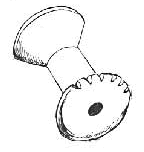January
2006 
|
Family Literacy/ABE/ ESL
http://www.funsci.com/fun3_en/toys/toys.htm - In many countries around the world, children can't buy toys because they're too expensive. So these children learn to build them themselves. We can learn from them. Build a self-propelling car, a cable car, a motorboat, a go-cart, a city cart, a bicycle, a blow pipe, a button whisk, a phone, and more. Materials? Heck, get some sewing spools, buttons, cans - lots of stuff you usually throw away. For ESL students or low-level native readers, you know what to do. Copy and paste the instructions on your computer. Rewrite the instructions at a lower reading level. How? Follow the basic rule: short, short , short: simple, short sentences; short, familiar words; and short, active and familiar verbs (no passive voice!!!). Long means more difficult in all reading-level assessments. Pictures help, too.
For example, take a sample from the site above and shorten everything:
1. "Spools are little wooden cylinders with raised edges which kept thread in place. A hole in the middle holds them to sewing machines. These supports, today hard to find, were used to hold thread. In every house there were seamstresses, so often these spools were everywhere, and because they were reusable, they certainly were not thrown away."
| 2. Spools are little objects that people use for sewing. Spools hold the thread. They have two wide circles at the end. They have a cylinder between the two ends. The cylinder has a hole in the middle. That keeps it on the machine. Sometimes, spools have notches. Notches make rough edges to hold the thread. Spools were in every house a long time ago. Now people can buy cheap clothes. Then they had to make them. After they used the tread, people kept the spools. Kids loved to make toys with them. |  |
Well, you get the idea. Lots of repetition of new words, too.
If you want to get serious, you can find information on my two favorite methods at the following sites:
- SMOG - http://uuhsc.utah.edu/pated/authors/readability.html
- Fry - http://www.pfizerhealthliteracy.com/improving_fry.html - has some links to exercises to practice.
GED (and other students with assistance in reading instructions, as seen above)
http://www.funsci.com/fun3_en/ucomp1/ucomp1.htm - Build a One-Dollar Microscope - Very interesting and fun.
http://www.exploratorium.edu/snacks/bicycle_wheel_gyro.html - Build a Bicycle Wheel Gyro - Super cheap and fun.
http://members.aol.com/filmgroup/china.htm - Construct a simple, reusable Chinese Lantern
Some may say, "Why bother with all of these projects? My students need to improve levels not have all of this worthless fun!" For a very good reason:authenticity.
"Trends in educational reform might be summed up in the one word, 'authentic.'" ("Public Access to the Internet," Beverly Hunter, 1995, Program Manager in the Educational Technologies group at Bolt Beranek and Newman, Inc. (BBN) in Cambridge, Massachusetts. She is author of 25 published books and computer-based learning materials and over 100 articles and technical reports in this field.)
In other words, we need to get real. Abstract concepts work with some people: the "A" students. Most of those we teach need to connect "rules" to something in their lives. Let's give them a hand.
"It only takes a little mouse. Click on that and you've got the whole world on the computer."--Fifth-grade student
Sign up Now
Pam Smith has again provided funding to help AEFLA-funded programs apply technology in teaching and learning. Last year, 4CVRC offered the following topics for training, which are still open for choices: (I had a great time wandering around the state with my computer show.)
1. Work in a Windows environment.
2. Create program flyers in Publisher or Word.
3. Create self-running Power Point segments for marketing programs, providing intake information, and training.
4. Create E-books from family stories (Even Start, family literacy)
5. Create student writing in Acrobat (ABE, ESL, GED, workplace, family literacy)
This year, we have added the following topics, along with any topic of your choice that relates to using technology for learning:
1. Apply best online practices for ESL students at all levels.
2. Develop and publish short online projects in science and math that incorporate academic skills.
3. Create and publish student projects in Word.
4. Create a group CD with occupational activities at low-reading levels.
5. Create and publish writing templates for ESL and ABE students.
6. Create and publish basic math templates for ESL and ABE students.
7. Your choice
How it works
- Fill out an online application with your choices. You will receive graduate credit from Adams State if you complete all requirements for follow-up after training.
- I will attempt to cluster dates so that I can do one or two programs in the same area around the same dates. I have six laptops loaded with XP and Office 2003. All computers have wireless cards. If your choice involves Internet connectivity, you need to have a connection available.
- Participants will be encouraged to share their products at the upcoming Rendezvous 2006. All products we create will be published online at our new site that feeds into the e-Colorado Portal. Here's your chance for fame if you have been waiting.
Your cost? Commitment. That's it. Pam has done her part. Now it's your turn!
Apply at http://reconnectioncompany.com/Quask/application_for_tech_training_06.htm.
Hope to see you soon. Leecy